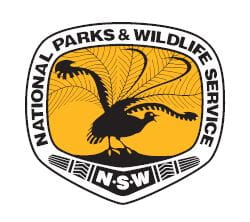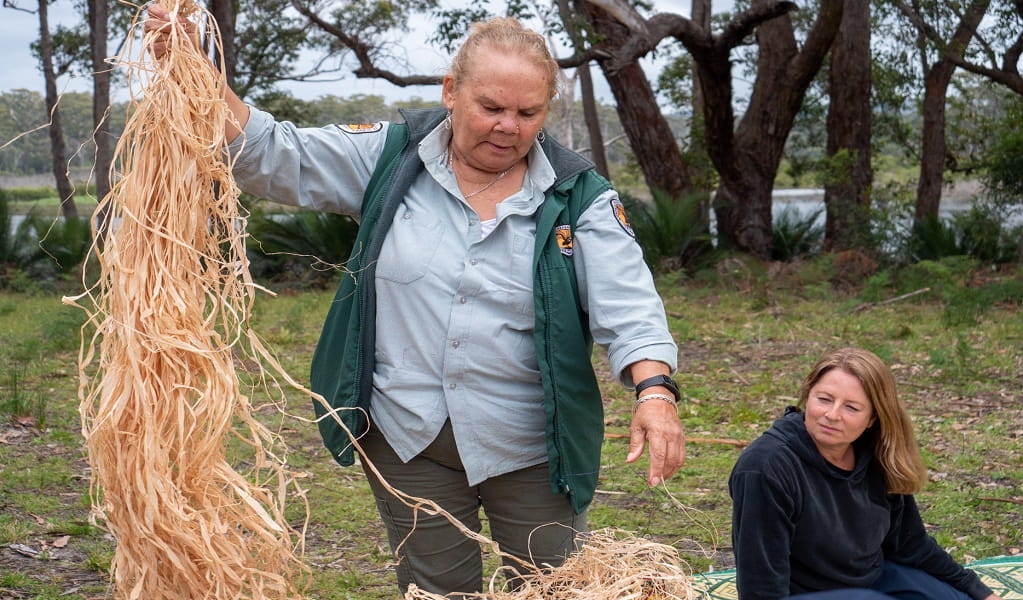Traditional weaving workshop: Eurobodalla
Eurobodalla National Park
Overview
Get creative on a traditional weaving workshop in Eurobodalla National Park, between Bermagui and Narooma. Learn Aboriginal weaving techniques and see how these ancient skills carry a strong connection to Aboriginal culture.
- When
2025:
17 July and 30 September.
2026:
8 and 15 January.
Tour times: 10am to 12pm and 1pm to 3pm
- Accessibility
- Medium
- Grade
- Easy. Suitable for all ages.
- Price
-
Adult/child $25 per person. Children must be accompanied by an adult. Accompanying adults need to book and pay.
- Entry fees
- Park entry fees apply
- Meeting point
- Shelter shed at Mystery Bay lookout.
- Bookings
- Bookings required. Phone 0400 816 822 for more information or book online.
- Availability
- Tours available during school holidays and by request for groups and schools (minimum 14 people). Email us for group bookings.
Join an Aboriginal NSW National Parks guide for a traditional weaving workshop at Mystery Bay lookout in Eurobodalla National Park.
Learn how to weave with grasses, reeds and natural materials. After you’ve honed your skills, you’ll have the opportunity to weave your own souvenir to take home with you.
As you explore your creative side, your guide will share traditional techniques used to weave baskets, carry bags and other items for daily use. You’ll discover how these ancient skills and practices carry a strong cultural connection.
Local alerts
For the latest updates on fires, closures and other alerts in this area, see https://www.nationalparks.nsw.gov.au/things-to-do/events/traditional-weaving-workshop-eurobodalla/local-alerts
Bookings
- National Parks Contact Centre
- 7am to 7pm daily
- 1300 072 757 (13000 PARKS) for the cost of a local call within Australia excluding mobiles
- parks.info@environment.nsw.gov.au
Operated by

- NSW National Parks & Wildlife Service
Park info
- in Eurobodalla National Park in the South Coast region
Eurobodalla National Park is always open but may have to close at times due to poor weather or fire danger.
Visitor info
All the practical information you need to know about Traditional weaving workshop: Eurobodalla .
Maps and downloads
Learn more
Traditional weaving workshop: Eurobodalla is in Eurobodalla National Park. Here are just some of the reasons why this park is special:
Aboriginal cultural heritage

Eurobodalla National Park is the traditional Country of the Yuin People. The park's landscape provided a rich source of food, shelter, medicines and weapons and continues to be an important place for Aboriginal people today. Walk the Bingi Dreaming track to follow the footsteps of the Brinja-Yuin People. Dreaming tracks traditionally linked the places visited by local Aboriginal people, then extended to connect other places utilised by neighbouring clans so that all Aboriginal people in Australia were connected by these unique highways.
- Aboriginal culture tours at Eurobodalla Follow Aboriginal Dreaming tracks in Eurobodalla National Park on a guided tour with Minga Aboriginal Cultural Services. Take part in cultural activities and share in the local knowledge of the Yuin People.
- Bingi Dreaming track Head out for a day walk on the Bingi Dreaming track, a coastal walk that traces the ancient Song Lines of the Yuin Aboriginal people. Enjoy stunning views as you walk.
- Guided Aboriginal culture walk with a Yuin Elder Trace the footsteps of the Yuin People along Bingi Dreaming track in Eurobodalla National Park with Southbound Escapes. Hear Dreamtime stories and learn about Aboriginal culture on this 2-hour walking tour.
- Traditional weaving workshop: Eurobodalla Get creative on a traditional weaving workshop in Eurobodalla National Park, between Bermagui and Narooma. Learn Aboriginal weaving techniques and see how these ancient skills carry a strong connection to Aboriginal culture.
Birds galore

Eurobodalla National Park provides an important habitat for a wide variety of birds, with 131 bird species having been recorded in the park. Estuaries and headlands within the park are important over-wintering areas for migratory birds, including 17 species of waders. In the summer, you may be lucky enough to see little terns nesting on the ground on sand islands, sandspits and dunes. If you do, please take care not to disturb this precious bird. You may also catch a glimpse of a sooty owl roosting in eucalypt forests in deep moist gullies, or the hooded plover which was only recently recorded in the park with potential threats similar to those of the little tern.
- Bingi Dreaming track Head out for a day walk on the Bingi Dreaming track, a coastal walk that traces the ancient Song Lines of the Yuin Aboriginal people. Enjoy stunning views as you walk.
Historic heritage

The period from the 1840's to the 1900's saw a rapid development of the area as a result of several often short-lived gold rushes, the growth of more intensive pastoral and agricultural land uses, and the expansion of timber getting activities. Many small towns grew up throughout the area, often acting as transport hubs and points of supply for surrounding districts. South Head at Moruya has many reminders of the important role shipping played, including several breakwaters and training walls that guided shipping through the river mouth, as well as the pilot's cottage and several smaller buildings situated on the headland.
Water abounds

Eurobodalla National Park contains a range of aquatic environments, including lagoons, lakes, estuaries, sheltered and wild beaches that protect a wide variety of plants and animals. For visitors, these aquatic environments offer a huge range of water-based activities, like waterskiing and boating at Corunna Lake, fishing and swimming around Mullimburra Point, surfing at 1080 Beach and paddling on Brou Lake and around Lake Tuross. It's the perfect place to visit during the summer holidays.
Plants and animals protected in this park
Animals
-

White-bellied sea eagle (Haliaeetus leucogaster)
White-bellied sea eagles can be easily identified by their white tail and dark grey wings. These raptors are often spotted cruising the coastal breezes throughout Australia, and make for some scenic bird watching. Powerful Australian birds of prey, they are known to mate for life, and return each year to the same nest to breed.
-

Australian pelican (Pelecanus conspicillatus)
The curious pelican is Australia’s largest flying bird and has the longest bill of any bird in the world. These Australian birds are found throughout Australian waterways and the pelican uses its throat pouch to trawl for fish. Pelicans breed all year round, congregating in large colonies on secluded beaches and islands.
-

Humpback whale (Megaptera novaeangliae)
The humpback whale has the longest migratory path of any mammal, travelling over 5000km from its summer feeding grounds in Antarctica to its breeding grounds in the subtropics. Its playful antics, such as body-rolling, breaching and pectoral slapping, are a spectacular sight for whale watchers in NSW national parks.
-

Yellow-tailed black cockatoo (Calyptorhynchus funereus)
The yellow-tailed black cockatoo is one of the largest species of parrot. With dusty-black plumage, they have a yellow tail and cheek patch. They’re easily spotted while bird watching, as they feed on seeds in native forests and pine plantations.
-

Peron's tree frog (Litoria peroni)
Peron’s tree frog is found right across NSW. These tree-climbing and ground-dwelling Australian animals can quickly change colour, ranging from pale green-grey by day, to a reddish brown with emerald green flecks at night. The male frog has a drill-like call, which has been described as a 'maniacal cackle’.

